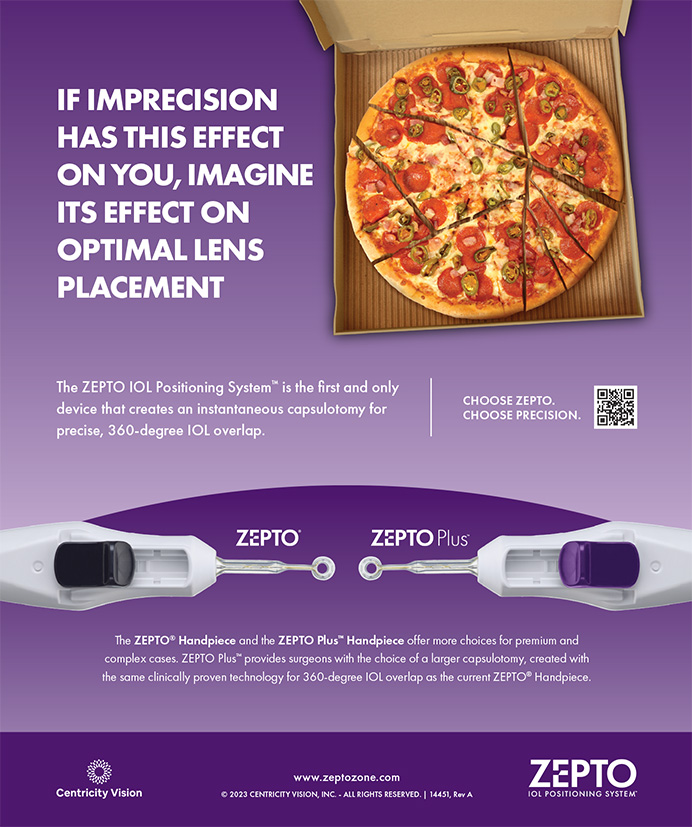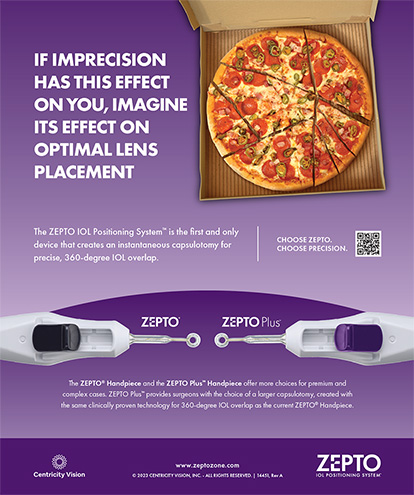Every cataract surgeon occasionally encounters “positive pressure” characterized by a marked tendency toward anterior chamber shallowing. The surgeon should try to determine the etiology, which might include extrinsic pressure from the speculum, lid squeezing, or periocular hemorrhage. Intrinsic factors can be many, including intraoperative capsular block, fluid misdirection, scleral collapse, torn capsule, and choroidal hemorrhaging or effusion. If the patient is coughing or contracting their stomach muscles, this can be instantly relieved by either a cough drop or the opportunity to urinate. If the etiology is not readily apparent, a series of generic surgical maneuvers may prove helpful.
MAINTAIN A SMALL RHEXIS SIZE
If there is positive pressure during the capsulorhexis, it is better to keep the size of the rhexis a bit smaller than usual because chamber shallowing tends to enlarge the rhexis. Healon5 (Pharmacia Corporation, Peapack, NJ) has been very beneficial in both deepening the chamber as well as facilitating a precise capsulorhexis size and shape, even when marked positive pressure is present.
If the iris tends to leap into the incision despite a well-constructed incision, remove a bit of the viscoelastic material with a 27-gauge cannula through the side port incision to lower the intraocular pressure, and facilitate gentle repositing of the iris. Next, place viscoelastic just inside the incision to help keep the iris out of the wound. The key is to then enter with the phacoemulsification tip without irrigation, waiting until the tip is inside the eye before resuming infusion. Otherwise, infusion would simply displace the viscoelastic and cause recurrence of the iris movement into the wound blocking the tip entry.
LOWER THE ASPIRATION RATE
When phacoemulsification begins and the chamber shows a strong tendency to shallow, another trick is to lower the aspiration rate, as this determines the movement of fluid out of the eye when the tip is unoccluded. Most surgeons are familiar with elevating the bottle, but if the cause has been a zonular or capsular break, it is better to reduce the aspiration rate than to elevate the hydrostatic pressure, which could displace the nucleus posteriorly. It is imperative that the surgeon is prepared to perform a Kelman posterior-assisted levitation maneuver should the nucleus start to fall (Figure 1).
If the eye is highly hyperopic with a short axial length, the surgeon should be familiar with performing pars plana aspiration of vitreous, initially described by David Kasner, MD, and recently published by David Chang, MD.1 I have found that if one can successfully debulk a portion of the nucleus, a reasonable working space can be attained, and the nucleus can be divided or cracked. Another trick is to place a dull second instrument against the central capsule with gentle posterior pressure, creating a ravine or a V-shaped space that will allow the emulsification to proceed directly over the instrument.
When the nucleus has been propelled forward out of the bag, I have even filled the anterior and posterior chamber with viscoelastic material and completed the emulsification using very brief bursts of ultrasonic energy. The surgeon must be aware of the greater risk of an incision burn in this setting.
DRY CORTICAL REMOVAL
Marked positive pressure does not permit the surgeon to relax after emulsification. When the capsular bag is closed by positive pressure, which creates a convex posterior capsule, the cortical removal can be extremely difficult. The new Silicone I/A tip (Alcon Surgical, Fort Worth, TX) adds enormous safety to the cortical removal and capsule vacuuming because the silicone material makes it nearly impossible to tear the capsule. Another invaluable trick is the technique of dry cortical removal, which requires filling the capsular bag with viscoelastic and then using a straight and a curved cannula to remove the cortex 360o. The size of the cannula depends on the viscosity of the viscoelastic agent, and I have designed several different cannula shapes with Storz (St. Louis, MO) to facilitate entry into the capsular bag beneath the incision.
IOL INSERTION
Before placing the IOL into the capsular bag, I will usually try to visualize the posterior segment through a proprietary hand-held lens (Osher 78 D MaxField; Ocular Instruments, Bellevue, WA) that I designed many years ago. The microscope is simply elevated several inches and the lens is placed just above the eye, which brings the fundus into clear focus. Using this lens, I have been able to diagnose a choroidal hemorrhage that would certainly have been a contraindication to enlarging the incision. I have also found that I can insert the IOL through an unenlarged incision, even in the face of a limited choroidal hemorrhage as long as the viscoelastic maintains some working space.
The key trick is to become familiar with a maneuver that permits repositioning of the IOL from the anterior chamber into the capsular bag. I use a curved Y-hook in my left hand through which I feed the trailing haptic, depressing the lens as it is being rotated clockwise with a straight Y-hook in my right hand (Figure 2). This is a wonderful technique. By injecting the newer SA60AT single-piece acrylic IOL (Alcon Surgical), all intraocular gymnastics are simplified because of the smaller insertion profile, the slow unfolding, and the unique flexibility of the haptics.
VISCOELASTIC REMOVAL
Finally, if positive pressure persists after the IOL is in the bag, removing the viscoelastic can be fraught with danger. I used to insert a miniature I/A tip, which would minimize the separation of the incision. A better technique is to restrain the IOL with a 27-gauge cannula on a 3-mL syringe filled with BSS (Alcon) placed through the second incision as the I/A is introduced. Next, I perform this same safety step again after removing the viscoelastic while withdrawing the I/A device (Figure 3).
In the face of intense positive pressure, it is not safe to insert any device through the main incision, and I introduce the same 27-gauge cannula through the second incision, directing it behind the IOL into the capsular bag to remove residual viscoelastic. The cohesiveness of Healon5 is advantageous because after injecting a small volume of BSS solution, the Healon5 can be easily aspirated from the capsular bag in small aliquots. Using this maneuver, the surgeon can be certain that the capsular bag does not contain any residual viscoelastic material, eliminating the possibility of a postoperative capsular block syndrome. The same maneuver can then be used to remove any remaining viscoelastic from the anterior chamber, alternately aspirating Healon5 and then instilling either BSS or Miochol (Novartis, Atlanta, GA) through the second incision.
It is fortunate that we do not have to rely on these tricks very often, but the surgeon must be prepared to use these emergency maneuvers in order to achieve the safest result in the face of intraoperative positive pressure.
Robert H. Osher, MD, is Professor of Ophthalmology at the University of Cincinnati College of Medicine and the Cincinnati Eye Institute. He is a consultant with Alcon Surgical and Pharmacia Corporation. Dr. Osher may be reached at (513) 984-5133; rhosher@cincinnatieye.com1. Chang D: Pars plana vitreous tap for phacoemulsification in the crowded eye. J Cataract Refract Surg 27:1911-1914, 2001


